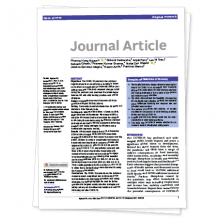Journal article
Feb 11 2020

Suboptimal infant and young child feeding practices in rural Boucle du Mouhoun, Burkina Faso: Findings from a cross-sectional population-based survey (Sarrasat S., 2019. PLOS One)
Mothers in the rural Boucle de Mouhoun Region of Burkina Faso had low levels of knowledge of IYCF and practices, according to this study: 60% of children had the minimum meal frequency, while only 18% benefited from the minimum dietary diversity and 13% received minimum acceptable diet.
Journal article
Nov 15 2019

Predictors of exclusive breastfeeding across three time points in Bangladesh (Blackstone SR., 2018. International Health)
This study explored predictors of exclusive breastfeeding (EBF) in Bangladesh using data from the Bangladesh Demographic and Health Survey from 2007, 2011, and 2014, focusing on reasons why rates of EBF changed over those time periods.
Journal article
Aug 01 2019

Does health worker performance affect clients’ health behaviors? A multilevel analysis from Bangladesh (Epstein, A., 2019. BMC Health Services Research)
In this study, reseearchers found evidence for an association between health worker compliance and client health behaviors; however, small effect sizes suggest that behavior change is multifactorial and affected by factors beyond care quality.
Journal article
Jun 01 2019

Using Multilevel Modeling to Understand Individual and Community-level Determinants of Anemia in Ethiopia
Journal article
Feb 15 2019

The effect of the Alive & Thrive initiative on exclusive breastfeeding in rural Burkina Faso: a repeated cross-sectional cluster randomised controlled trial (Cresswell J., 2019. Lancet Global Health)
The benefits of exclusive breastfeeding on mortality, health, and development of children have been well documented.
Journal article
Jan 11 2019

Nutrition interventions integrated into an existing maternal, neonatal, and child health program reduced food insecurity among recently delivered and pregnant women in Bangladesh (Frongillo E., 2019. Journal of Nutrition)
This study investigated whether participation in nutrition-focused antenatal care can be a way to reduce food insecurity during pregnancy and the postpartum period.

